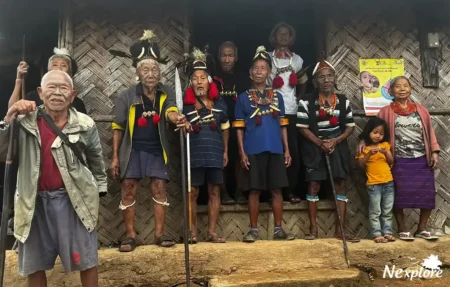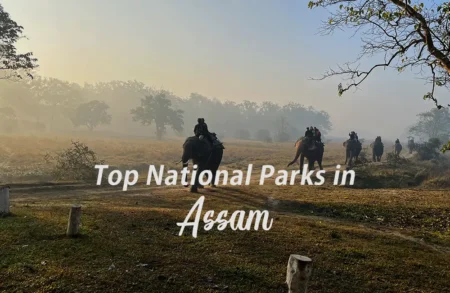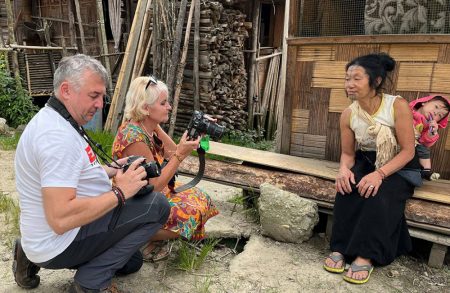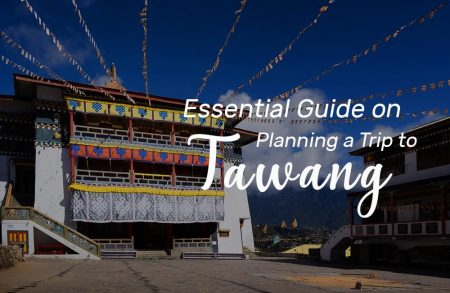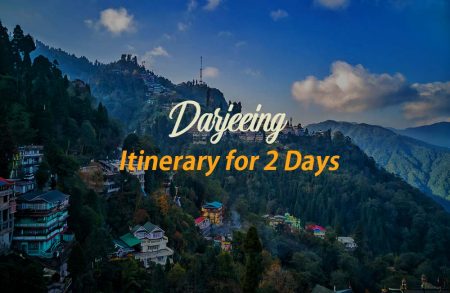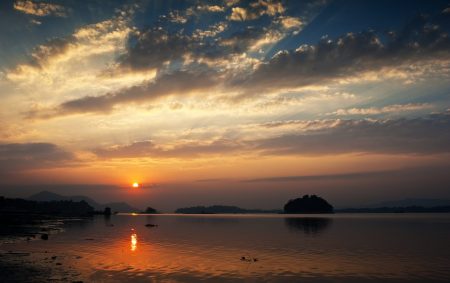Located in the Northeast corner of India, Northeast India consists of 7 states in India. All states have diverse cultures and landscapes and are rich with experiences you won’t find anywhere else.
But timing your visit can make or break your trip. The region’s weather is unpredictable, especially during monsoons, and access to top attractions often depends on the season.
If you’re planning a trip to Assam, Meghalaya, and Arunachal Pradesh, here’s everything you need to know about when to go, what to expect in each season, and what to avoid.
Winter (October to February)
Assam in Winter
If you’re wondering about the best time to visit Assam, winter is your answer. From October to March, the weather is crisp and pleasant, ideal for exploring the state’s iconic wildlife sanctuaries and tea estates.
- Kaziranga National Park, Manash National Park and all other national parks in Assam are fully open during this season. Jeep and elephant safaris run daily, offering close-up views of rhinos, elephants, and even tigers if you’re lucky.
- The Majuli River Island, the historic city Sibsar and Guwahati are also accessible and enjoyable during winter. You can take part in the Ali-Aye-Ligang festival, which is held in Majuli in February.
- Tea estates in Upper Assam are lush and inviting, in this season with plucking and processing in full swing.
Arunachal Pradesh in Winter – Snow in Tawang, Anini and Mayodia
While most of Northeast India shivers lightly in winter, Arunachal Pradesh takes it up a notch, especially in Tawang, Anini, Mayodia etc. From January to April, the region transforms into a snow-laced dreamland.
- Tawang, perched at 10,000 ft, sees regular snowfall. It’s the perfect time to see the Sela Pass in its full white glory.
- Adventure lovers can trek, ride, or drive through scenic high-altitude terrain.
- It’s also a great time for the Losar Festival (Tibetan New Year), usually in February or March.
Avoid visiting Arunachal from June to August. The monsoon makes roads dangerous, landslides are common, and access to remote areas becomes unreliable.
Spring (March to April)
Spring is a fantastic time to explore Northeast India. The weather is mild, and the landscapes are in bloom. It’s a safe and comfortable season to travel, with minimal rainfall, clear skies.
Assam in Spring
Spring is one of the most enjoyable seasons to visit Assam. Temperatures are pleasant, and nature is at its most inviting.
- Rangali Bihu Festival is the cultural highlight of the season. It marks the Assamese New Year and is celebrated with traditional dance, music, and feasts across the state.
- Wildlife Sanctuaries like Kaziranga, Manas, and Pobitora remain open, with excellent conditions for safaris and birdwatching.
- The Brahmaputra River is calm, making this a good time for river cruises and island visits (like Majuli).
- March and April are the best time to enjoy birding and butterfly watching in Dibru Saikhowa.
Arunachal Pradesh in Spring – Clear Roads and Cultural Richness
- Spring is one of the best times to visit Arunachal Pradesh, The snow begins to melt in higher altitudes, making roads more accessible while still offering views of snow-capped peaks. The weather is cool and stable—ideal for trekking, sightseeing, and photography.
- You can attend vibrant tribal festivals like Mopin (celebrated by the Galo tribe in April) or Siang River Festival, which showcase the unique traditions, dances, and crafts of the region.
Meghalaya in Spring
Spring in Meghalaya offers a calm and scenic experience, with lush landscapes and lower tourist crowds compared to the monsoon.
- Waterfalls still flow, but trails and roads are drier and easier to navigate than during peak rainy season.
- It’s a great time for trekking to living root bridges, exploring caves and enjoying the green countryside in Meghalaya.
- The weather is fresh and moderately cool, perfect for nature walks and village stays.
Sikkim and Darjeeling in Spring
Spring is the peak season for visiting Sikkim and Darjeeling, thanks to blooming flowers, clear skies, and refreshing mountain air.
- Yumthang Valley come alive with rhododendrons and orchids.
- Gurudongmar Lake and North Sikkim are accessible from April onward, offering dramatic high-altitude scenery.
- Darjeeling’s famous tea gardens look their best in spring, and the Toy Train rides are more enjoyable in this weather.
- Local festivals and the pleasant climate also make it a great time for photography and leisurely exploration.
Spring offers the best of both worlds—great weather and full access to the rich cultural and natural diversity of Northeast India. Whether you’re here for festivals, wildlife, mountain views, or peace and quiet, March to May is the best time to plan your adventure.
Check our guide on festivals in Northeast India, you don’t want to miss during your visit.
Monsoon (June to August):
Monsoon in Northeast India is a mixed bag. While some areas transform into lush, misty wonderlands, others become difficult or even dangerous to access. Here’s what to know for each state:
Meghalaya in Monsoon
If you’ve dreamed of walking through clouds, hearing the roar of massive waterfalls, and watching mist swirl around green cliffs, monsoon is the best time to visit Meghalaya.
- Iconic waterfalls like Nohkalikai Falls, Wei Sawdong, Seven sister falls, Dainthlen Falls etc come alive in full force.
- Living root bridges are surrounded by dense jungle and flowing streams, offering unforgettable treks.
- Thick fog and heavy mist create surreal, cinematic views throughout Cherrapunji and Mawsynram.
Important tip: Monsoon is peak tourist season in Cherrapunji. If you plan to visit between July and August, book your stay 2–3 months in advance. Most quality hotels and homestays are fully booked well ahead of time.
Sikkim and Darjeeling in the monsoon
Monsoon in Sikkim and Darjeeling is unpredictable. While some areas remain accessible and beautiful, others—especially in the north sikkim—can become risky.
- Light rain and mist add to the charm of Darjeeling and Gangtok, with fewer crowds than usual.
- However, avoid North Sikkim (including places like Lachung, Lachen, and Gurudongmar Lake). Roads are often closed due to landslides and poor visibility.
✅ If you’re looking for quiet hill town vibes with greenery and soft rain, stick to the southern parts of Sikkim and central Darjeeling.
Assam and Arunachal Pradesh – Best to Avoid
The monsoon is not the best time to visit Assam or Arunachal Pradesh. The heavy rainfall between June and September creates serious travel disruptions.
- All national parks in Assam, including Kaziranga, Manas, Orang and Pobitora are closed due to flooding.
- Road conditions deteriorate, especially in hilly and remote regions. Landslides are frequent in Arunachal.
- River cruises and ferry services are either suspended or run with limited access due to strong currents.
- Flash floods and transportation delays are common, especially around the Brahmaputra basin.
If your plans include wildlife safaris, mountain drives, or trekking, it’s best to skip Assam and Arunachal during monsoon.
Quick Monsoon Recap by Region
| State/Region | Travel Status | What to Know |
| Meghalaya | ✅ Highly recommended | Spectacular waterfalls, foggy views, root bridge treks; book early |
| Sikkim & Darjeeling | ⚠️ Mixed | South Sikkim & Darjeeling are fine; avoid North Sikkim |
| Assam | ❌ Not recommended | National parks closed, heavy rains, risk of floods and delays |
| Arunachal Pradesh | ❌ Not recommended | Landslides, poor road conditions, very limited accessibility |
Autumn
Autumn in Northeast India (September to November):
Autumn is a short but magical season across Northeast India. As the monsoon withdraws, the skies clear, humidity drops, and the lush greenery remains vibrant—setting the perfect stage for sightseeing, photography, and cultural experiences. Autumn and the arrival of spring offer clear skies, wonderful Festivals, and stunning views.
- Meghalaya becomes a serene escape with fewer tourists compared to the monsoon months. Waterfalls still flow beautifully, and trails are quieter and easier to explore. If you’re aiming to capture the iconic floating boats in Dawki’s crystal-clear waters, the post-September to winter months are the best time to enjoy clear views.
- The state also hosts the Cherry Blossom Festival, usually in October or November, celebrating local music, food, and art under blooming pink canopies.
- In Assam, major national parks like Kaziranga, Manas, and Pobitora reopen in October. It’s a great time to start wildlife safaris. The lower humidity and cooler evenings in autumn and winter make it ideal for outdoor activities like trekking, birdwatching, and exploring tea estates and other monuments, etc.
- Autumn is also the best time to visit Arunachal Pradesh. Roads are more stable, the weather is clear, and visibility is excellent for scenic drives and mountain views. You can attend the vibrant Ziro Music Festival in September, a favourite among indie music fans, or experience Tibetan culture at the Tawang Festival, usually held in September or October.
- In Assam, Durga Puja celebrations add cultural richness during this period, with grand pandals, lights, and traditional performances lighting up towns and cities.
- Meanwhile, Sikkim sees some of its best weather in autumn. Clear skies and crisp air make October and November ideal for enjoying panoramic views of the Kanchenjunga range. You can also catch local events like the Red Panda Winter Festival, which showcases Sikkimese culture, food, and crafts.
In short, autumn is a golden window to explore the Northeast at its most accessible and photogenic, with just the right mix of good weather, fewer crowds, and vibrant festivals.
Quick Summary: Best Time to Visit Northeast India
| State | Best Season | What to Expect | What to Avoid |
| Assam | October to March | Wildlife safaris, tea estates, and cultural festivals | June–September (monsoon/flooding) |
| Meghalaya | June to September (monsoon lovers) October to March (general travel) |
Waterfalls, foggy landscapes, root bridges | None, but book early in the monsoon |
| Arunachal Pradesh | January to April October to May |
Snowfall in Tawang, tribal festivals, scenic drives | June–August (landslides, rains) |
| Sikkim | October – December March – May |
Valley of Flowers in full bloom, snow-covered Nathula pass | Monsoon (June–August (landslides, rains) |
| Nagaland | December February – August |
Enjoy the Hornbill Festival
Best time for Dzuku Valley |
Monsoon (June–August (landslides, rains |
Final Tips
- Always check weather forecasts for each location. Rain patterns vary from year to year.
- Carry layers. Even in spring, evenings in Arunachal can get chilly.
- Permits are required for Arunachal Pradesh.
Wrapping Up
The best time to visit Assam, Meghalaya, and Arunachal Pradesh depends on what kind of traveller you are. Wildlife enthusiast? Head to Assam in winter. Love snow? Arunachal in early spring is unbeatable. Obsessed with waterfalls and clouds? Book Meghalaya during the monsoon—just don’t wait till the last minute.
With smart planning, each of these states offers a completely different version of Northeast India. Pick your season wisely and you’ll be rewarded with an unforgettable journey.




